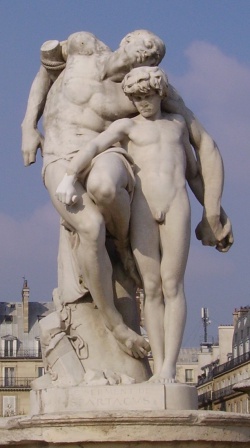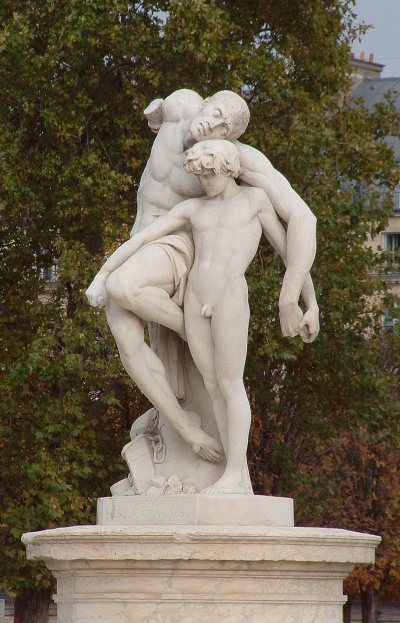The Oath of Spartacus (Louis-Ernest Barrias)
"' The oath of Spartacus"' is a sculpture marble of "'Louis-Ernest Barrias"', between 1869 and 1871 based on a plaster of the same artist. It can be seen from 1975 in Paris, in the garden of the Tuileries.
Description

This sculpture depicts a dying man attached to the remains of a tree on which he was crucified. His left arm and his head are based on a boy young who stands naked, standing at his side. This last, the abundant hair and determined look, shakes in his right hand a knife while his left hand (damaged) affectionately holds two fingers of the hand of the torment.
The title suggests that this is child Spartacus, vowing to avenge the man he supported in his last moments. Empire, the Crucifixion was a punishment reserved for those who were not Roman citizenship, most often of slave s of the robbers or pirates, sometimes prisoners of war or condemned for political reasons. In any event, this poignant scene is actually completely imaginary: indeed, it knows nothing of childhood the young Thracian who around the age of thirty years, between-73 and -71, will be shaking the Roman power in the worst slave revolt that she has had to face.
Analysis

The strength of the work is the contrast between how sweet and loving boy who stands against the man and displayed determination. There a lot of tenderness in his way as a child two fingers of the left hand of the man, almost dragging his left shoulder under the powerful arms collapsing and rest his right arm through the legs of the man... At the same time, his head slightly forward shows looking determined and hard, pointed out by pinched lips and shadow project bits from his forehead. In the same way, the way to hold the knife, the blade toward the back of the hand to move from top to bottom, like divine justice, leaves no doubt about its intentions: it will avenge the man for which he feels tenderness and who is dying at his side.
See also
= Related articles.